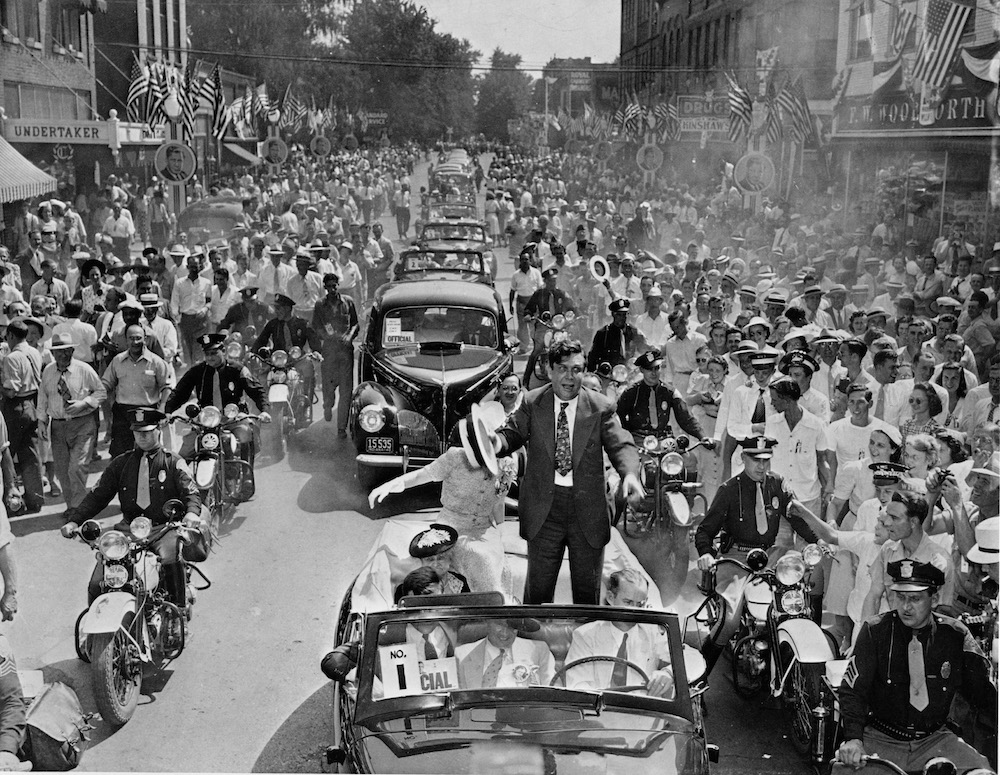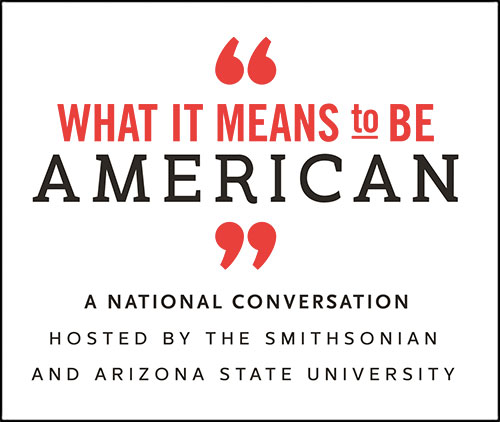
Wendell Willkie, Republican presidential candidate, parades through his hometown, Elwood, Ind., Aug. 17, 1940. He was en route to a local park where he delivered his acceptance speech as the party’s nominee. (AP Photo/John D. Collins)
 Later this week, the historic nomination of the first female candidate for president by a major political party at the Democratic National Convention in Philadelphia is sure to generate considerable hoopla. But, as with all U.S. presidential conventions in recent decades, the outcome is already certain.
Later this week, the historic nomination of the first female candidate for president by a major political party at the Democratic National Convention in Philadelphia is sure to generate considerable hoopla. But, as with all U.S. presidential conventions in recent decades, the outcome is already certain.
Such predictability was not always the case. In fact, three-quarters of a century ago, the City of Brotherly Love played host to a very different convention—one whose outcome was so unexpected it became known as the “Miracle in Philadelphia.”
This was before the age of modern primaries, when the convention was less of an award ceremony, and more the actual contest. When the 1940 Republican National Convention opened, just 300 of the 1,000 delegates were pledged to a candidate. The contenders included such heavyweights as former President Herbert Hoover (attempting a comeback), Manhattan district attorney Thomas E. Dewey, the governor of South Dakota, and three U.S. senators, among them Michigan’s Arthur H. Vandenberg and Ohio’s Robert A. Taft.
And then there was Wendell L. Willkie, the boisterous head of the New York City-based Commonwealth & Southern Corporation, the nation’s largest energy holding company. Willkie’s previous foray into the political realm was as a delegate at the 1924 and 1932 National Conventions—as a Democrat.
But when President Franklin D. Roosevelt proposed the Tennessee Valley Authority to compete with private utilities, Willkie soured on the Democrats and became a leading spokesman for the business sector against New Deal policies. Willkie nonetheless described himself as a “liberal” with an ironclad commitment to civil rights and individual liberties. He said that if elected he planned to desegregate the government, the armed forces, and Washington, D.C.
Still, it was quite a leap to go from Democratic National Convention delegate to Republican presidential candidate. Willkie had not even bothered to mount a formal campaign, having declared his “availability” for nomination just 48 days before the convention’s first gavel fell. He had no campaign funds and no campaign manager or hired spokesman. A Gallup poll six weeks prior to the convention reflected Willkie’s minimal efforts, showing 67 percent support among Republican voters for Dewey, 14 percent for Vandenberg, 12 percent for Taft, and 3 percent for Willkie.
Yet it was Willkie who, to the astonishment of everyone except himself, somehow managed to walk away with the nomination. How did an industrialist from Indiana—sometimes known as the “Barefoot Wall Street Lawyer” for the folksy Indiana ways he brought to the big city—manage to best his far better-known, better-connected and better-moneyed rivals?
The answer is both simple and complex. Only a month earlier, Hitler’s Nazi troops had stormed through Belgium, Luxembourg, the Netherlands, and France. More than 350,000 British and French troops, in full retreat, had staged a daring escape across the English Channel from Dunkirk. On the first evening of the convention, at a special session at Philadelphia’s Independence Hall broadcast via radio coast to coast, Republican National Chairman John Hamilton of Kansas addressed the country’s mounting fears. “The world is witnessing a terrible demonstration of how quickly the hard-earned rights of man can be destroyed,” Hamilton declared. “Individual liberty and opportunity are gone in much of the world; the rights of man, slowly built up over a thousand years, have vanished.” His speech concluded with a descendent of Benjamin Franklin ringing the Liberty Bell.
For the 1940 Republican presidential hopefuls, this state of affairs created a problem. All of the leading candidates were well-known isolationists, while Roosevelt, who was seeking an unprecedented third term, had been engaged globally for almost two terms. Indeed, the official Republican platform issued that week declared the party “firmly opposed to involving this nation in foreign war.” But it added, “The zero hour is here. America must prepare if it wants to defend our shores, our homes, our lives, and our most cherished ideals.”
Taft, son of President William Howard Taft, was the conservative leader of the U.S. Senate and the Republican establishment’s pick. Vandenberg, a longtime member of the Senate Foreign Relations Committee, was leader of the Senate’s isolationist block and an early frontrunner, subsequently knocked out by Dewey in the primaries. Dewey, the impeccably dressed, 38-year-old, gang-busting U.S. Attorney had narrowly lost the New York governor’s race in 1938. But he won nine out of 10 presidential primaries and came to the convention as the strong favorite.
Willkie, 48, was the sole internationalist—and the only contender with experience running a large organization. In 1929 he was hired as corporate counsel at Commonwealth & Southern and quickly rose through the ranks. Four years later, in the midst of the Great Depression and with the company on the verge of bankruptcy, he was made president. Willkie rebuilt the company, increasing business assets to more than $1 billion, employing 25,000 workers and bringing electricity for the first time to millions of people in 10 states.
In the run-up to the convention, as global tensions mounted, Willkie captured the imagination of the public and the media. U.S. News, Time, Life, Look, Fortune, and The Saturday Evening Post ran feature stories, and 10,000 “Willkie for President” clubs sprang up across the nation. By convention week, a Gallup poll suggested that Willkie had carved a big chunk out of Dewey’s lead. Dewey was still far ahead, at 47 percent. But Willkie was now in second position, at 29 percent, with the other contenders relegated to single digits.
As was the norm—before convention rule changes that went into effect in 1972—most delegates of both parties were either uncommitted or committed to a “Favorite Son” candidate from their state. All the 1940 candidates thought that if they could hold off Dewey on the first ballot they had a chance. But Willkie had momentum. During the convention, the Willkie for President clubs inundated the convention with more than a million pro-Willkie telegrams and letters, which were dumped at the delegates’ feet, while the balconies were stacked with supporters screaming, “We want Willkie! We want Willkie!”
Where did such enthusiastic support come from for this non-establishment candidate? Initially the clubs did emerge from the establishment, spurred by Republican strategist and Willkie supporter Oren Root. But that was just the beginning. The clubs—fueled by the barrage of national publicity and Willkie’s homespun personality—resonated with the public and spread rapidly and spontaneously across the nation, culminating in this moment of frenzied support.
On the first ballot, Dewey took the lead, with 360 of the 501 votes required to win. Taft, known as “Mr. Republican” and favored by uncommitted party-insider delegates, trailed with 189 votes, while Willkie started in third place with 105. But Dewey made a tactical error in not holding reserve votes for the second ballot, which would have helped create the impression of momentum. Instead he dropped to 338 while both Taft and Willkie gained ground. By the end of the fourth ballot Dewey’s support had collapsed to 250. Taft gained momentum with 254, while Willkie surged forward with 306. The relentless chanting from the balcony continued: “We want Willkie! We want Willkie!”
On the crucial sixth ballot, state delegations stampeded to Willkie. The darkest dark horse since the days of Abraham Lincoln and James Garfield won the prize. Afterwards in his small hotel room, the nominee laughingly told the press, “I guess the first thing I’ll have to do is change my registration from Democrat to Republican.”
George Gallup called Willkie’s charge to the nomination “the most astonishing” in the brief history of polling. Journalist H.L. Mencken wrote, “I am convinced that the nomination of Willkie was managed by the Holy Ghost in person.”
The campaign was almost as exciting. Roosevelt later said that despite his victory—amassing 27 million votes to Willkie’s 22 million, the most secured by any Republican presidential candidate to date—the “liberal” Republican known for carrying his own bags hit him with the toughest fight of his political career. Roosevelt so respected Willkie that soon after his inauguration he sent his former political foe traveling throughout Europe and Asia as his personal diplomatic representative during World War II. Willkie’s resulting book, One World, was a bestseller. In 1944, Willkie briefly mounted a fresh campaign for president, but dropped out after he was defeated by party conservatives in the Wisconsin primary. He died soon after, at age 52, from a series of heart attacks.
Though Willkie never realized his presidential dream, his spectacular performance at the 1940 convention stands as one of the all-time greatest presidential convention upsets. And Willkie’s strong showing against FDR in the general election ensured him—and his ideas—a seat at the table. In 2016, when many American voters across the ideological spectrum have again demonstrated their frustrations with the limitations of political insiders, history reminds us that our democratic institutions can, indeed, accommodate the demands of sudden popular change.
In “Beyond the Circus,” writers take us off the 2016 campaign trail and give us glimpses of this election season’s politically important places.




Send A Letter To the Editors